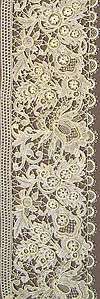Youghal lace
Youghal lace (or Point d'Irlande) is a needle lace inspired by Italian needle lace developed in Youghal, County Cork, Ireland.
Origins
Youghal lace was a top quality commercial product that ended with the First World War. Lace Making was taught in Youghal from 1845 by the Presentation Sisters. Mother Mary Ann Smith reverse-engineered some Italian lace to understand how it was made. She then taught the technique to local women and thus the school of lace began.[1]
Legacy
Among the finest pieces of lace made in Youghal was a train for Queen Mary worn on her visit to India in 1911 as its Empress. The skill of lace making is still retained in Youghal to this day, however most specimens are kept in private collections and rarely put up for sale. There is no written record of either the stitches or the general technique at the Convents themselves, but the puzzling obscurity is illuminated by a number of important survivals:
- A sampler of 43 stitches (in Kenmare Lace, similar to Youghal Lace), on display at the Kenmare Lace and Design Centre in Kenmare.
- A court train made for Queen Mary and worn by her at the Delhi Durbar of 1911.
- Two books of designs drawn in Chinese white on paper tinted beige, pink, azure, crimson or midnight blue.
- The Needlecraft Practical Journal no.106, published by William Briggs under the Penelope trademark, c1909.
- Two books of designs for needlepoint lace, hand-painted by the nuns of St Clares Convent in the late 19th century, on display at the Kenmare Lace and Design Centre, Kenmare.
- A number of smaller pieces are available for viewing at Youghal Heritage Centre
In addition there are some surviving pieces from that era.
References
- ↑ The Art of Lacemaking - Ann Collier, 1986 - ISBN 0-7153-8846-0
The designs in Kenmare are examples of lace designs. None of them were drawn in youghal by the Presentation sisters there.
Pat Earnshaw has written two books, Youghal and other Irish Lace and Youghal Lace, the craft and the cream.
